Communication Impact on Customer Satisfaction: Research Proposal
VerifiedAdded on 2022/11/17
|13
|4714
|1
Project
AI Summary
This research proposal investigates the impact of communication between front office and back-office management on customer satisfaction within the hotel industry, using Sofitel Auckland Viaduct Harbour as a case study. The proposal outlines the background of the hotel, identifies the problem of declining customer satisfaction due to communication issues, and highlights the significance of the research. It includes a literature review examining key concepts and influential studies related to communication strategies, customer service, and workforce optimization within the hospitality sector. The review explores the relationship between front and back-office operations, technological services, and guest experiences. The research aims to answer questions regarding the effect of communication on customer satisfaction and explore strategies for improving communication between the two departments. The proposal also discusses the scope of the review, aspects of the topic that will be discussed or excluded, and the relevance of the research to the selected organization. The proposal examines how communication affects front office and back office management on customer satisfaction within Sofitel Auckland Viaduct Harbour hotel, and how communication strategies could be used by Sofitel Auckland Viaduct Harbour hotel to manage the front office and back office in terms of providing higher customer satisfaction.
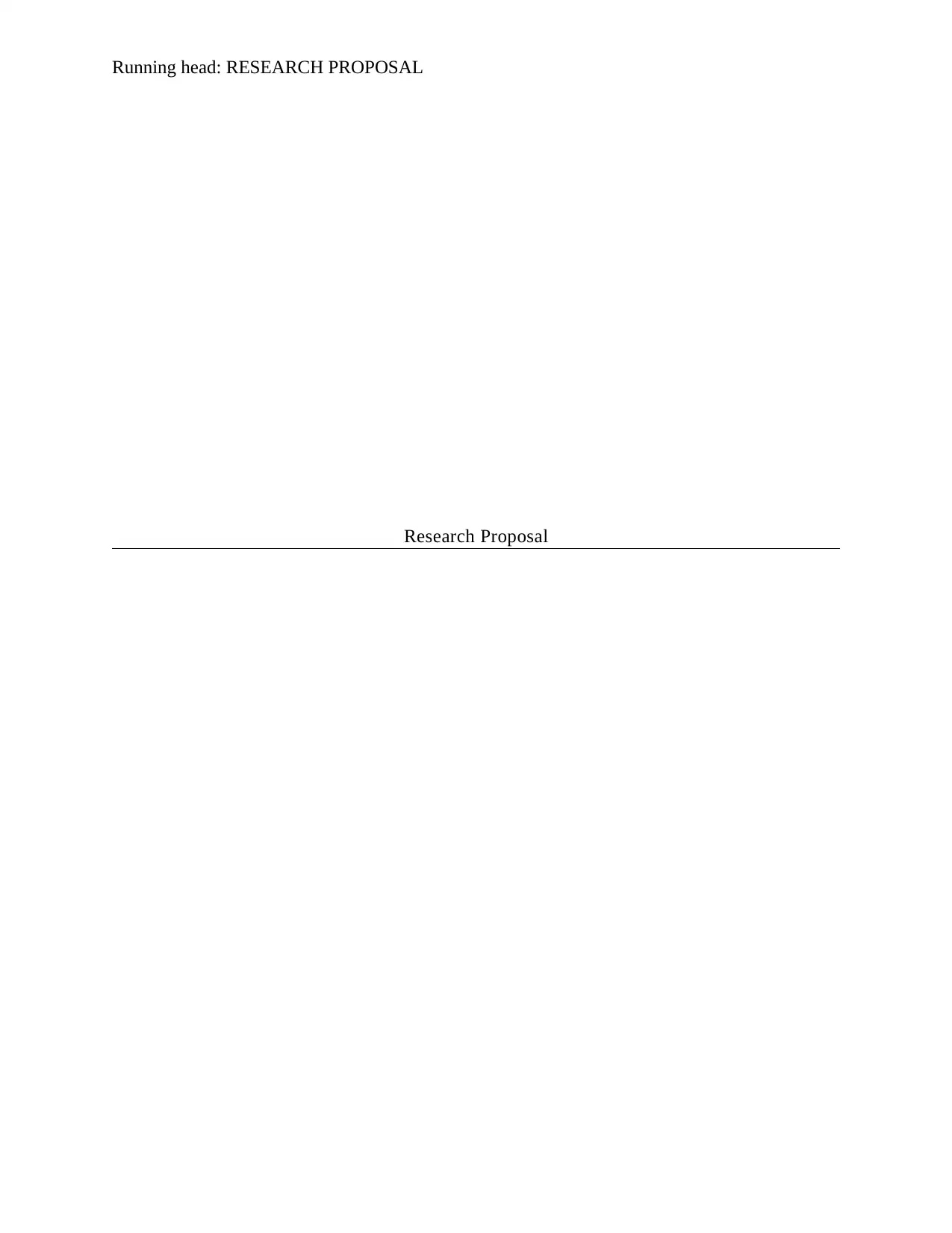
Running head: RESEARCH PROPOSAL
Research Proposal
Research Proposal
Paraphrase This Document
Need a fresh take? Get an instant paraphrase of this document with our AI Paraphraser
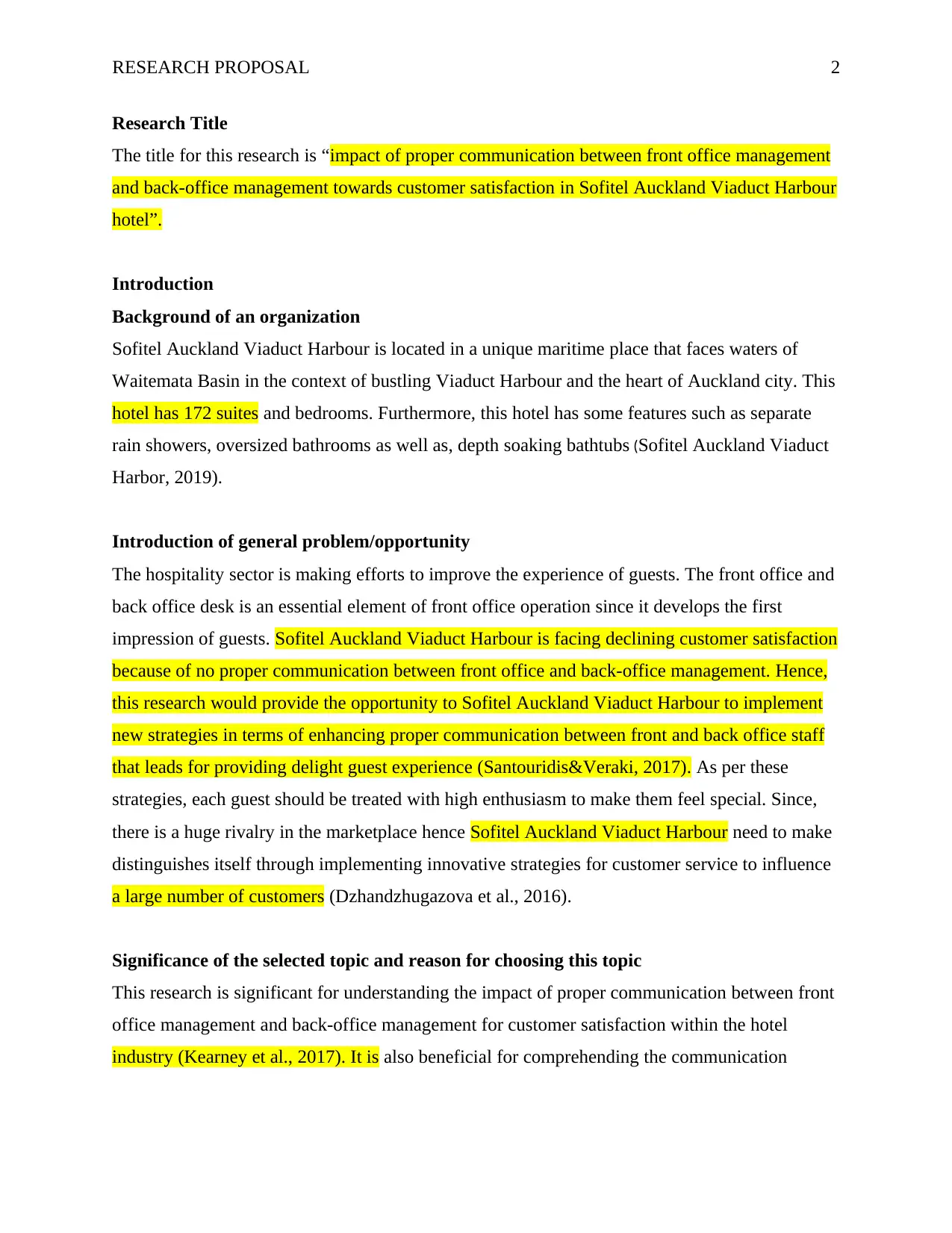
RESEARCH PROPOSAL 2
Research Title
The title for this research is “impact of proper communication between front office management
and back-office management towards customer satisfaction in Sofitel Auckland Viaduct Harbour
hotel”.
Introduction
Background of an organization
Sofitel Auckland Viaduct Harbour is located in a unique maritime place that faces waters of
Waitemata Basin in the context of bustling Viaduct Harbour and the heart of Auckland city. This
hotel has 172 suites and bedrooms. Furthermore, this hotel has some features such as separate
rain showers, oversized bathrooms as well as, depth soaking bathtubs (Sofitel Auckland Viaduct
Harbor, 2019).
Introduction of general problem/opportunity
The hospitality sector is making efforts to improve the experience of guests. The front office and
back office desk is an essential element of front office operation since it develops the first
impression of guests. Sofitel Auckland Viaduct Harbour is facing declining customer satisfaction
because of no proper communication between front office and back-office management. Hence,
this research would provide the opportunity to Sofitel Auckland Viaduct Harbour to implement
new strategies in terms of enhancing proper communication between front and back office staff
that leads for providing delight guest experience (Santouridis&Veraki, 2017). As per these
strategies, each guest should be treated with high enthusiasm to make them feel special. Since,
there is a huge rivalry in the marketplace hence Sofitel Auckland Viaduct Harbour need to make
distinguishes itself through implementing innovative strategies for customer service to influence
a large number of customers (Dzhandzhugazova et al., 2016).
Significance of the selected topic and reason for choosing this topic
This research is significant for understanding the impact of proper communication between front
office management and back-office management for customer satisfaction within the hotel
industry (Kearney et al., 2017). It is also beneficial for comprehending the communication
Research Title
The title for this research is “impact of proper communication between front office management
and back-office management towards customer satisfaction in Sofitel Auckland Viaduct Harbour
hotel”.
Introduction
Background of an organization
Sofitel Auckland Viaduct Harbour is located in a unique maritime place that faces waters of
Waitemata Basin in the context of bustling Viaduct Harbour and the heart of Auckland city. This
hotel has 172 suites and bedrooms. Furthermore, this hotel has some features such as separate
rain showers, oversized bathrooms as well as, depth soaking bathtubs (Sofitel Auckland Viaduct
Harbor, 2019).
Introduction of general problem/opportunity
The hospitality sector is making efforts to improve the experience of guests. The front office and
back office desk is an essential element of front office operation since it develops the first
impression of guests. Sofitel Auckland Viaduct Harbour is facing declining customer satisfaction
because of no proper communication between front office and back-office management. Hence,
this research would provide the opportunity to Sofitel Auckland Viaduct Harbour to implement
new strategies in terms of enhancing proper communication between front and back office staff
that leads for providing delight guest experience (Santouridis&Veraki, 2017). As per these
strategies, each guest should be treated with high enthusiasm to make them feel special. Since,
there is a huge rivalry in the marketplace hence Sofitel Auckland Viaduct Harbour need to make
distinguishes itself through implementing innovative strategies for customer service to influence
a large number of customers (Dzhandzhugazova et al., 2016).
Significance of the selected topic and reason for choosing this topic
This research is significant for understanding the impact of proper communication between front
office management and back-office management for customer satisfaction within the hotel
industry (Kearney et al., 2017). It is also beneficial for comprehending the communication
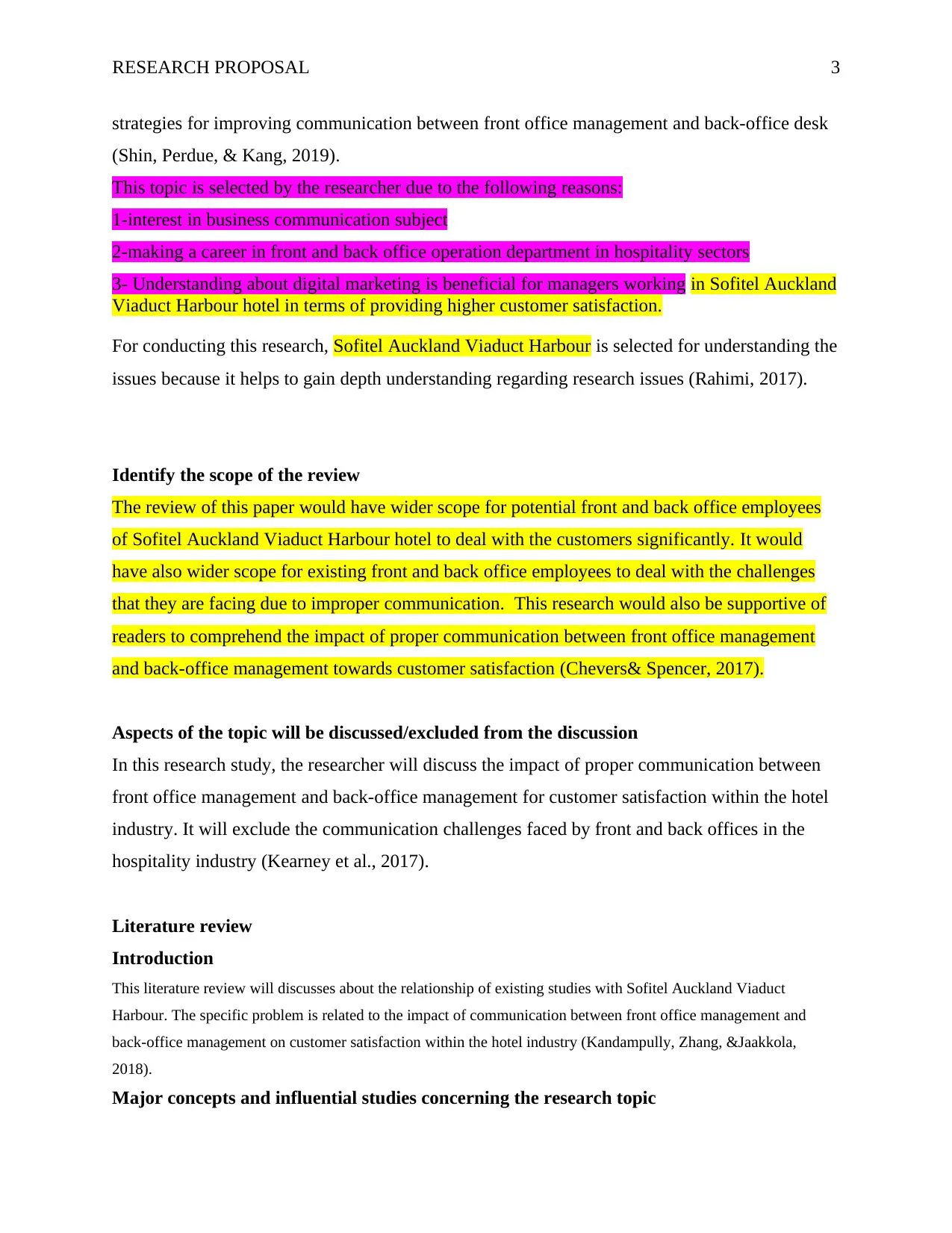
RESEARCH PROPOSAL 3
strategies for improving communication between front office management and back-office desk
(Shin, Perdue, & Kang, 2019).
This topic is selected by the researcher due to the following reasons:
1-interest in business communication subject
2-making a career in front and back office operation department in hospitality sectors
3- Understanding about digital marketing is beneficial for managers working in Sofitel Auckland
Viaduct Harbour hotel in terms of providing higher customer satisfaction.
For conducting this research, Sofitel Auckland Viaduct Harbour is selected for understanding the
issues because it helps to gain depth understanding regarding research issues (Rahimi, 2017).
Identify the scope of the review
The review of this paper would have wider scope for potential front and back office employees
of Sofitel Auckland Viaduct Harbour hotel to deal with the customers significantly. It would
have also wider scope for existing front and back office employees to deal with the challenges
that they are facing due to improper communication. This research would also be supportive of
readers to comprehend the impact of proper communication between front office management
and back-office management towards customer satisfaction (Chevers& Spencer, 2017).
Aspects of the topic will be discussed/excluded from the discussion
In this research study, the researcher will discuss the impact of proper communication between
front office management and back-office management for customer satisfaction within the hotel
industry. It will exclude the communication challenges faced by front and back offices in the
hospitality industry (Kearney et al., 2017).
Literature review
Introduction
This literature review will discusses about the relationship of existing studies with Sofitel Auckland Viaduct
Harbour. The specific problem is related to the impact of communication between front office management and
back-office management on customer satisfaction within the hotel industry (Kandampully, Zhang, &Jaakkola,
2018).
Major concepts and influential studies concerning the research topic
strategies for improving communication between front office management and back-office desk
(Shin, Perdue, & Kang, 2019).
This topic is selected by the researcher due to the following reasons:
1-interest in business communication subject
2-making a career in front and back office operation department in hospitality sectors
3- Understanding about digital marketing is beneficial for managers working in Sofitel Auckland
Viaduct Harbour hotel in terms of providing higher customer satisfaction.
For conducting this research, Sofitel Auckland Viaduct Harbour is selected for understanding the
issues because it helps to gain depth understanding regarding research issues (Rahimi, 2017).
Identify the scope of the review
The review of this paper would have wider scope for potential front and back office employees
of Sofitel Auckland Viaduct Harbour hotel to deal with the customers significantly. It would
have also wider scope for existing front and back office employees to deal with the challenges
that they are facing due to improper communication. This research would also be supportive of
readers to comprehend the impact of proper communication between front office management
and back-office management towards customer satisfaction (Chevers& Spencer, 2017).
Aspects of the topic will be discussed/excluded from the discussion
In this research study, the researcher will discuss the impact of proper communication between
front office management and back-office management for customer satisfaction within the hotel
industry. It will exclude the communication challenges faced by front and back offices in the
hospitality industry (Kearney et al., 2017).
Literature review
Introduction
This literature review will discusses about the relationship of existing studies with Sofitel Auckland Viaduct
Harbour. The specific problem is related to the impact of communication between front office management and
back-office management on customer satisfaction within the hotel industry (Kandampully, Zhang, &Jaakkola,
2018).
Major concepts and influential studies concerning the research topic
⊘ This is a preview!⊘
Do you want full access?
Subscribe today to unlock all pages.

Trusted by 1+ million students worldwide
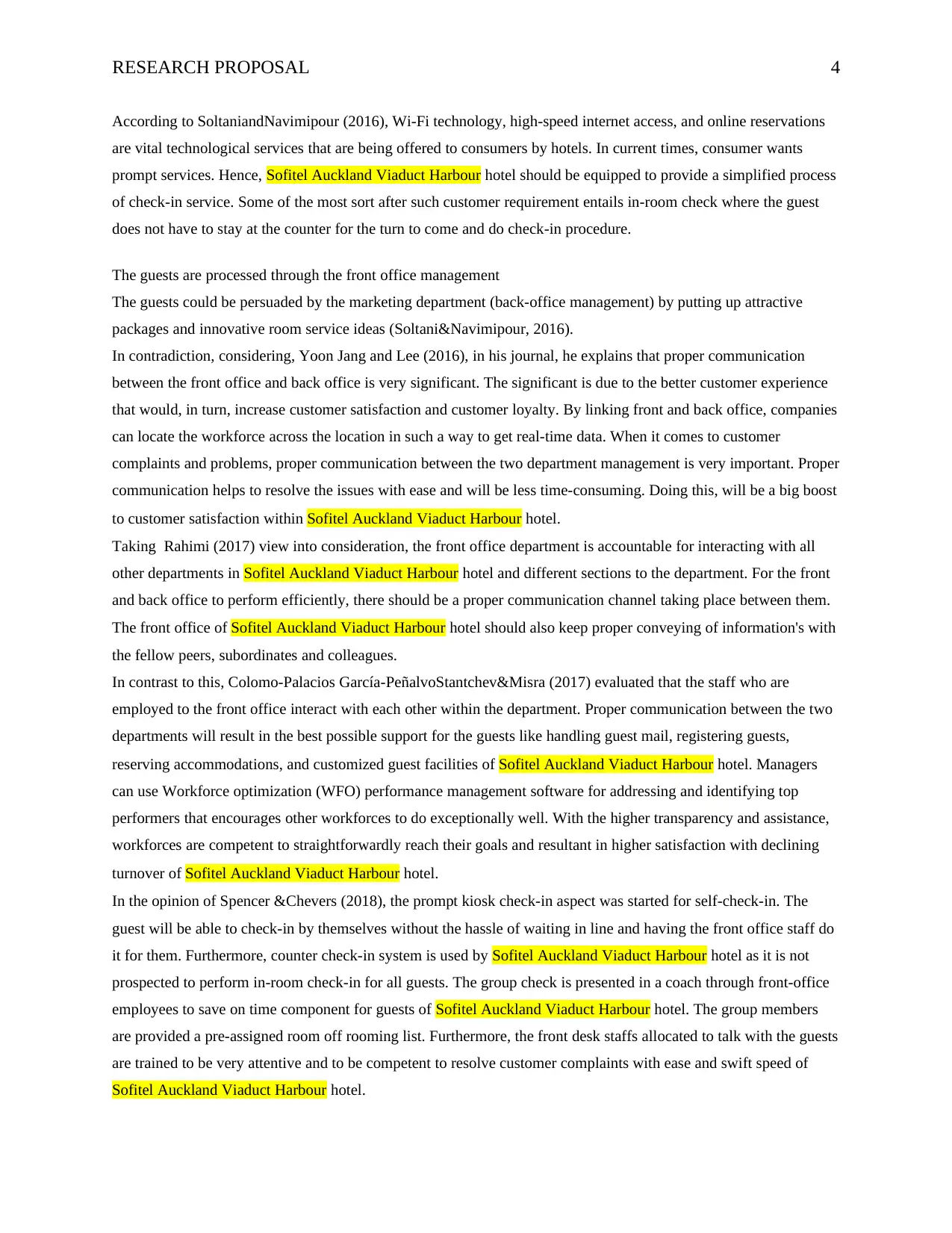
RESEARCH PROPOSAL 4
According to SoltaniandNavimipour (2016), Wi-Fi technology, high-speed internet access, and online reservations
are vital technological services that are being offered to consumers by hotels. In current times, consumer wants
prompt services. Hence, Sofitel Auckland Viaduct Harbour hotel should be equipped to provide a simplified process
of check-in service. Some of the most sort after such customer requirement entails in-room check where the guest
does not have to stay at the counter for the turn to come and do check-in procedure.
The guests are processed through the front office management
The guests could be persuaded by the marketing department (back-office management) by putting up attractive
packages and innovative room service ideas (Soltani&Navimipour, 2016).
In contradiction, considering, Yoon Jang and Lee (2016), in his journal, he explains that proper communication
between the front office and back office is very significant. The significant is due to the better customer experience
that would, in turn, increase customer satisfaction and customer loyalty. By linking front and back office, companies
can locate the workforce across the location in such a way to get real-time data. When it comes to customer
complaints and problems, proper communication between the two department management is very important. Proper
communication helps to resolve the issues with ease and will be less time-consuming. Doing this, will be a big boost
to customer satisfaction within Sofitel Auckland Viaduct Harbour hotel.
Taking Rahimi (2017) view into consideration, the front office department is accountable for interacting with all
other departments in Sofitel Auckland Viaduct Harbour hotel and different sections to the department. For the front
and back office to perform efficiently, there should be a proper communication channel taking place between them.
The front office of Sofitel Auckland Viaduct Harbour hotel should also keep proper conveying of information's with
the fellow peers, subordinates and colleagues.
In contrast to this, Colomo-Palacios García-PeñalvoStantchev&Misra (2017) evaluated that the staff who are
employed to the front office interact with each other within the department. Proper communication between the two
departments will result in the best possible support for the guests like handling guest mail, registering guests,
reserving accommodations, and customized guest facilities of Sofitel Auckland Viaduct Harbour hotel. Managers
can use Workforce optimization (WFO) performance management software for addressing and identifying top
performers that encourages other workforces to do exceptionally well. With the higher transparency and assistance,
workforces are competent to straightforwardly reach their goals and resultant in higher satisfaction with declining
turnover of Sofitel Auckland Viaduct Harbour hotel.
In the opinion of Spencer &Chevers (2018), the prompt kiosk check-in aspect was started for self-check-in. The
guest will be able to check-in by themselves without the hassle of waiting in line and having the front office staff do
it for them. Furthermore, counter check-in system is used by Sofitel Auckland Viaduct Harbour hotel as it is not
prospected to perform in-room check-in for all guests. The group check is presented in a coach through front-office
employees to save on time component for guests of Sofitel Auckland Viaduct Harbour hotel. The group members
are provided a pre-assigned room off rooming list. Furthermore, the front desk staffs allocated to talk with the guests
are trained to be very attentive and to be competent to resolve customer complaints with ease and swift speed of
Sofitel Auckland Viaduct Harbour hotel.
According to SoltaniandNavimipour (2016), Wi-Fi technology, high-speed internet access, and online reservations
are vital technological services that are being offered to consumers by hotels. In current times, consumer wants
prompt services. Hence, Sofitel Auckland Viaduct Harbour hotel should be equipped to provide a simplified process
of check-in service. Some of the most sort after such customer requirement entails in-room check where the guest
does not have to stay at the counter for the turn to come and do check-in procedure.
The guests are processed through the front office management
The guests could be persuaded by the marketing department (back-office management) by putting up attractive
packages and innovative room service ideas (Soltani&Navimipour, 2016).
In contradiction, considering, Yoon Jang and Lee (2016), in his journal, he explains that proper communication
between the front office and back office is very significant. The significant is due to the better customer experience
that would, in turn, increase customer satisfaction and customer loyalty. By linking front and back office, companies
can locate the workforce across the location in such a way to get real-time data. When it comes to customer
complaints and problems, proper communication between the two department management is very important. Proper
communication helps to resolve the issues with ease and will be less time-consuming. Doing this, will be a big boost
to customer satisfaction within Sofitel Auckland Viaduct Harbour hotel.
Taking Rahimi (2017) view into consideration, the front office department is accountable for interacting with all
other departments in Sofitel Auckland Viaduct Harbour hotel and different sections to the department. For the front
and back office to perform efficiently, there should be a proper communication channel taking place between them.
The front office of Sofitel Auckland Viaduct Harbour hotel should also keep proper conveying of information's with
the fellow peers, subordinates and colleagues.
In contrast to this, Colomo-Palacios García-PeñalvoStantchev&Misra (2017) evaluated that the staff who are
employed to the front office interact with each other within the department. Proper communication between the two
departments will result in the best possible support for the guests like handling guest mail, registering guests,
reserving accommodations, and customized guest facilities of Sofitel Auckland Viaduct Harbour hotel. Managers
can use Workforce optimization (WFO) performance management software for addressing and identifying top
performers that encourages other workforces to do exceptionally well. With the higher transparency and assistance,
workforces are competent to straightforwardly reach their goals and resultant in higher satisfaction with declining
turnover of Sofitel Auckland Viaduct Harbour hotel.
In the opinion of Spencer &Chevers (2018), the prompt kiosk check-in aspect was started for self-check-in. The
guest will be able to check-in by themselves without the hassle of waiting in line and having the front office staff do
it for them. Furthermore, counter check-in system is used by Sofitel Auckland Viaduct Harbour hotel as it is not
prospected to perform in-room check-in for all guests. The group check is presented in a coach through front-office
employees to save on time component for guests of Sofitel Auckland Viaduct Harbour hotel. The group members
are provided a pre-assigned room off rooming list. Furthermore, the front desk staffs allocated to talk with the guests
are trained to be very attentive and to be competent to resolve customer complaints with ease and swift speed of
Sofitel Auckland Viaduct Harbour hotel.
Paraphrase This Document
Need a fresh take? Get an instant paraphrase of this document with our AI Paraphraser
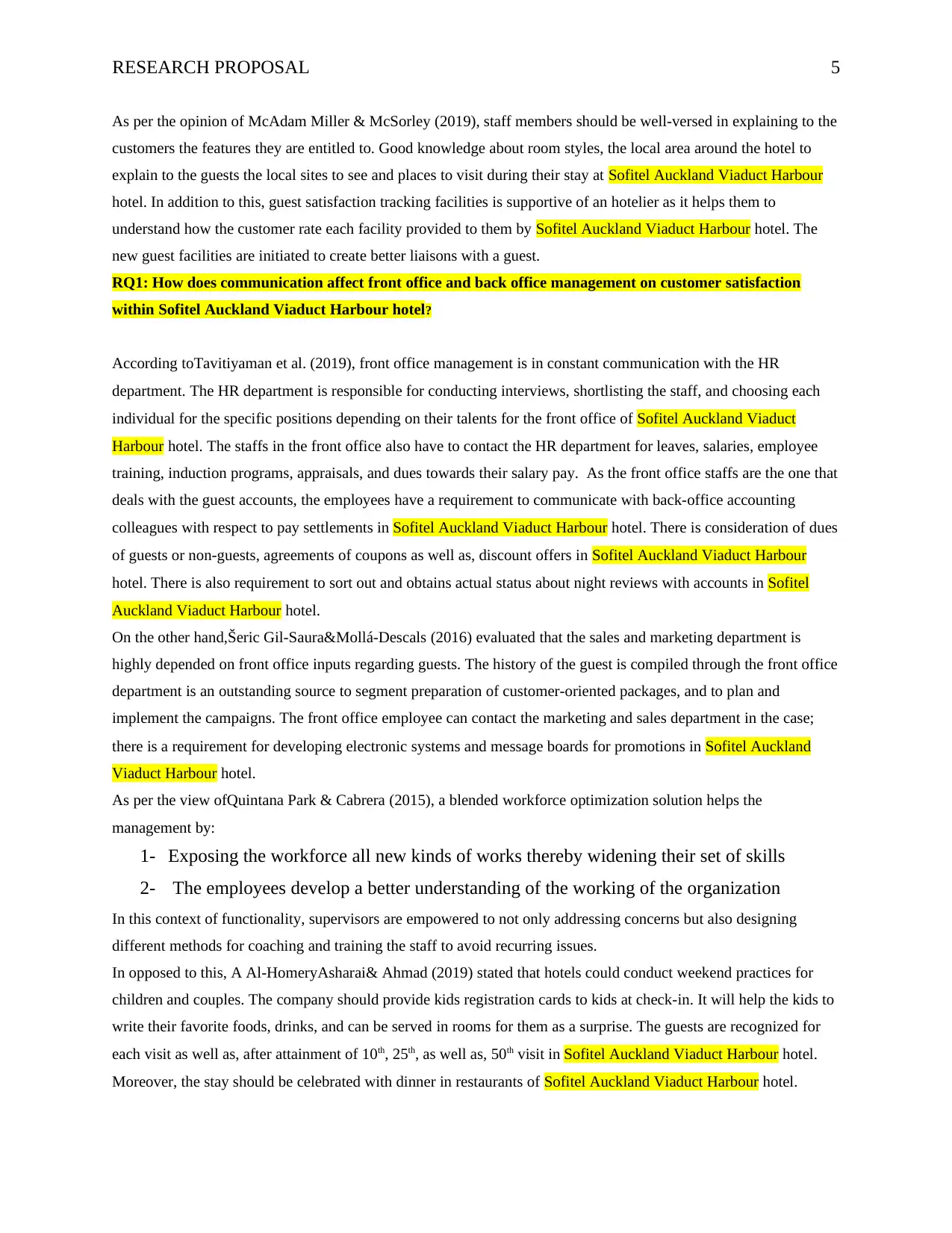
RESEARCH PROPOSAL 5
As per the opinion of McAdam Miller & McSorley (2019), staff members should be well-versed in explaining to the
customers the features they are entitled to. Good knowledge about room styles, the local area around the hotel to
explain to the guests the local sites to see and places to visit during their stay at Sofitel Auckland Viaduct Harbour
hotel. In addition to this, guest satisfaction tracking facilities is supportive of an hotelier as it helps them to
understand how the customer rate each facility provided to them by Sofitel Auckland Viaduct Harbour hotel. The
new guest facilities are initiated to create better liaisons with a guest.
RQ1: How does communication affect front office and back office management on customer satisfaction
within Sofitel Auckland Viaduct Harbour hotel?
According toTavitiyaman et al. (2019), front office management is in constant communication with the HR
department. The HR department is responsible for conducting interviews, shortlisting the staff, and choosing each
individual for the specific positions depending on their talents for the front office of Sofitel Auckland Viaduct
Harbour hotel. The staffs in the front office also have to contact the HR department for leaves, salaries, employee
training, induction programs, appraisals, and dues towards their salary pay. As the front office staffs are the one that
deals with the guest accounts, the employees have a requirement to communicate with back-office accounting
colleagues with respect to pay settlements in Sofitel Auckland Viaduct Harbour hotel. There is consideration of dues
of guests or non-guests, agreements of coupons as well as, discount offers in Sofitel Auckland Viaduct Harbour
hotel. There is also requirement to sort out and obtains actual status about night reviews with accounts in Sofitel
Auckland Viaduct Harbour hotel.
On the other hand,Šeric Gil-Saura&Mollá-Descals (2016) evaluated that the sales and marketing department is
highly depended on front office inputs regarding guests. The history of the guest is compiled through the front office
department is an outstanding source to segment preparation of customer-oriented packages, and to plan and
implement the campaigns. The front office employee can contact the marketing and sales department in the case;
there is a requirement for developing electronic systems and message boards for promotions in Sofitel Auckland
Viaduct Harbour hotel.
As per the view ofQuintana Park & Cabrera (2015), a blended workforce optimization solution helps the
management by:
1- Exposing the workforce all new kinds of works thereby widening their set of skills
2- The employees develop a better understanding of the working of the organization
In this context of functionality, supervisors are empowered to not only addressing concerns but also designing
different methods for coaching and training the staff to avoid recurring issues.
In opposed to this, A Al-HomeryAsharai& Ahmad (2019) stated that hotels could conduct weekend practices for
children and couples. The company should provide kids registration cards to kids at check-in. It will help the kids to
write their favorite foods, drinks, and can be served in rooms for them as a surprise. The guests are recognized for
each visit as well as, after attainment of 10th, 25th, as well as, 50th visit in Sofitel Auckland Viaduct Harbour hotel.
Moreover, the stay should be celebrated with dinner in restaurants of Sofitel Auckland Viaduct Harbour hotel.
As per the opinion of McAdam Miller & McSorley (2019), staff members should be well-versed in explaining to the
customers the features they are entitled to. Good knowledge about room styles, the local area around the hotel to
explain to the guests the local sites to see and places to visit during their stay at Sofitel Auckland Viaduct Harbour
hotel. In addition to this, guest satisfaction tracking facilities is supportive of an hotelier as it helps them to
understand how the customer rate each facility provided to them by Sofitel Auckland Viaduct Harbour hotel. The
new guest facilities are initiated to create better liaisons with a guest.
RQ1: How does communication affect front office and back office management on customer satisfaction
within Sofitel Auckland Viaduct Harbour hotel?
According toTavitiyaman et al. (2019), front office management is in constant communication with the HR
department. The HR department is responsible for conducting interviews, shortlisting the staff, and choosing each
individual for the specific positions depending on their talents for the front office of Sofitel Auckland Viaduct
Harbour hotel. The staffs in the front office also have to contact the HR department for leaves, salaries, employee
training, induction programs, appraisals, and dues towards their salary pay. As the front office staffs are the one that
deals with the guest accounts, the employees have a requirement to communicate with back-office accounting
colleagues with respect to pay settlements in Sofitel Auckland Viaduct Harbour hotel. There is consideration of dues
of guests or non-guests, agreements of coupons as well as, discount offers in Sofitel Auckland Viaduct Harbour
hotel. There is also requirement to sort out and obtains actual status about night reviews with accounts in Sofitel
Auckland Viaduct Harbour hotel.
On the other hand,Šeric Gil-Saura&Mollá-Descals (2016) evaluated that the sales and marketing department is
highly depended on front office inputs regarding guests. The history of the guest is compiled through the front office
department is an outstanding source to segment preparation of customer-oriented packages, and to plan and
implement the campaigns. The front office employee can contact the marketing and sales department in the case;
there is a requirement for developing electronic systems and message boards for promotions in Sofitel Auckland
Viaduct Harbour hotel.
As per the view ofQuintana Park & Cabrera (2015), a blended workforce optimization solution helps the
management by:
1- Exposing the workforce all new kinds of works thereby widening their set of skills
2- The employees develop a better understanding of the working of the organization
In this context of functionality, supervisors are empowered to not only addressing concerns but also designing
different methods for coaching and training the staff to avoid recurring issues.
In opposed to this, A Al-HomeryAsharai& Ahmad (2019) stated that hotels could conduct weekend practices for
children and couples. The company should provide kids registration cards to kids at check-in. It will help the kids to
write their favorite foods, drinks, and can be served in rooms for them as a surprise. The guests are recognized for
each visit as well as, after attainment of 10th, 25th, as well as, 50th visit in Sofitel Auckland Viaduct Harbour hotel.
Moreover, the stay should be celebrated with dinner in restaurants of Sofitel Auckland Viaduct Harbour hotel.
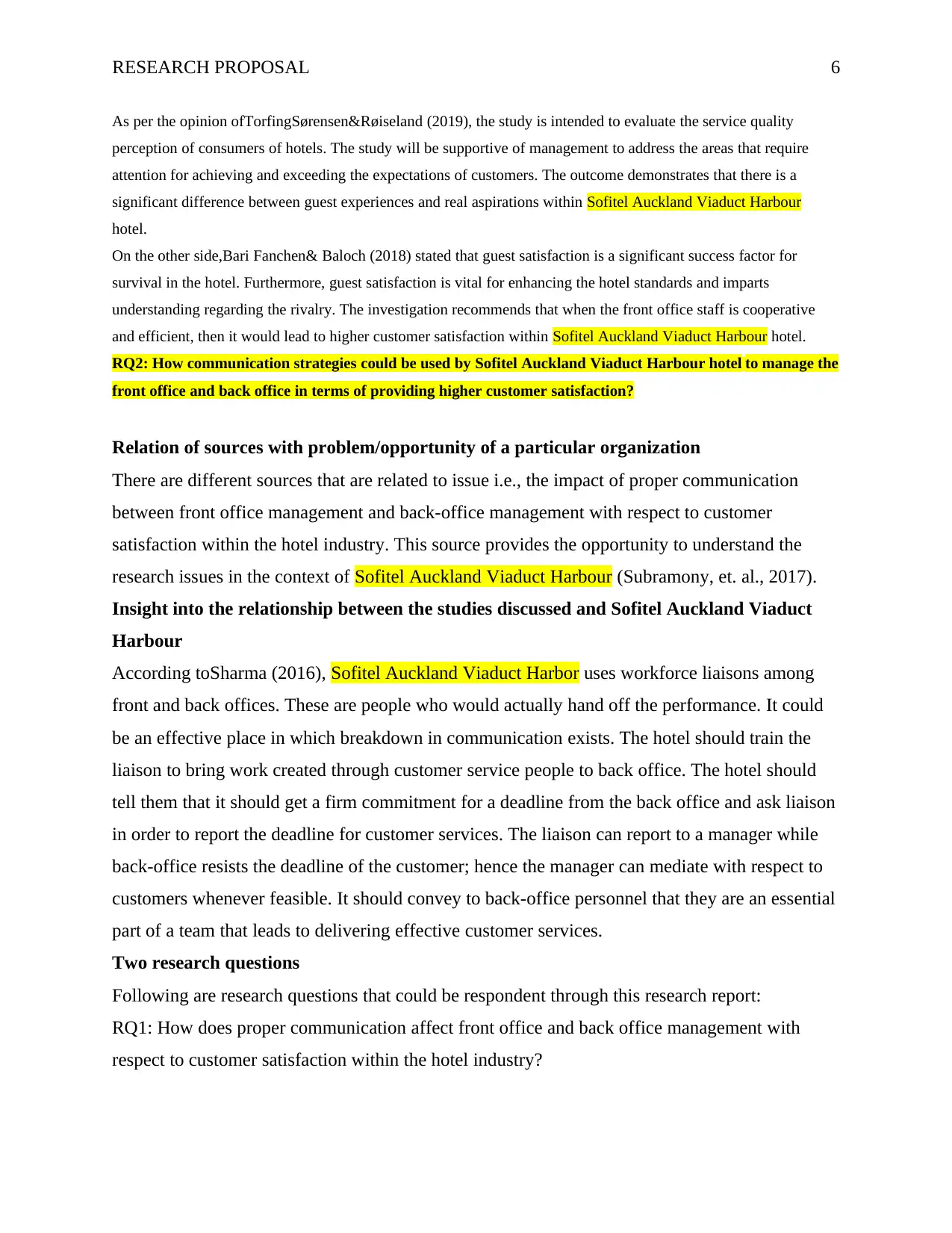
RESEARCH PROPOSAL 6
As per the opinion ofTorfingSørensen&Røiseland (2019), the study is intended to evaluate the service quality
perception of consumers of hotels. The study will be supportive of management to address the areas that require
attention for achieving and exceeding the expectations of customers. The outcome demonstrates that there is a
significant difference between guest experiences and real aspirations within Sofitel Auckland Viaduct Harbour
hotel.
On the other side,Bari Fanchen& Baloch (2018) stated that guest satisfaction is a significant success factor for
survival in the hotel. Furthermore, guest satisfaction is vital for enhancing the hotel standards and imparts
understanding regarding the rivalry. The investigation recommends that when the front office staff is cooperative
and efficient, then it would lead to higher customer satisfaction within Sofitel Auckland Viaduct Harbour hotel.
RQ2: How communication strategies could be used by Sofitel Auckland Viaduct Harbour hotel to manage the
front office and back office in terms of providing higher customer satisfaction?
Relation of sources with problem/opportunity of a particular organization
There are different sources that are related to issue i.e., the impact of proper communication
between front office management and back-office management with respect to customer
satisfaction within the hotel industry. This source provides the opportunity to understand the
research issues in the context of Sofitel Auckland Viaduct Harbour (Subramony, et. al., 2017).
Insight into the relationship between the studies discussed and Sofitel Auckland Viaduct
Harbour
According toSharma (2016), Sofitel Auckland Viaduct Harbor uses workforce liaisons among
front and back offices. These are people who would actually hand off the performance. It could
be an effective place in which breakdown in communication exists. The hotel should train the
liaison to bring work created through customer service people to back office. The hotel should
tell them that it should get a firm commitment for a deadline from the back office and ask liaison
in order to report the deadline for customer services. The liaison can report to a manager while
back-office resists the deadline of the customer; hence the manager can mediate with respect to
customers whenever feasible. It should convey to back-office personnel that they are an essential
part of a team that leads to delivering effective customer services.
Two research questions
Following are research questions that could be respondent through this research report:
RQ1: How does proper communication affect front office and back office management with
respect to customer satisfaction within the hotel industry?
As per the opinion ofTorfingSørensen&Røiseland (2019), the study is intended to evaluate the service quality
perception of consumers of hotels. The study will be supportive of management to address the areas that require
attention for achieving and exceeding the expectations of customers. The outcome demonstrates that there is a
significant difference between guest experiences and real aspirations within Sofitel Auckland Viaduct Harbour
hotel.
On the other side,Bari Fanchen& Baloch (2018) stated that guest satisfaction is a significant success factor for
survival in the hotel. Furthermore, guest satisfaction is vital for enhancing the hotel standards and imparts
understanding regarding the rivalry. The investigation recommends that when the front office staff is cooperative
and efficient, then it would lead to higher customer satisfaction within Sofitel Auckland Viaduct Harbour hotel.
RQ2: How communication strategies could be used by Sofitel Auckland Viaduct Harbour hotel to manage the
front office and back office in terms of providing higher customer satisfaction?
Relation of sources with problem/opportunity of a particular organization
There are different sources that are related to issue i.e., the impact of proper communication
between front office management and back-office management with respect to customer
satisfaction within the hotel industry. This source provides the opportunity to understand the
research issues in the context of Sofitel Auckland Viaduct Harbour (Subramony, et. al., 2017).
Insight into the relationship between the studies discussed and Sofitel Auckland Viaduct
Harbour
According toSharma (2016), Sofitel Auckland Viaduct Harbor uses workforce liaisons among
front and back offices. These are people who would actually hand off the performance. It could
be an effective place in which breakdown in communication exists. The hotel should train the
liaison to bring work created through customer service people to back office. The hotel should
tell them that it should get a firm commitment for a deadline from the back office and ask liaison
in order to report the deadline for customer services. The liaison can report to a manager while
back-office resists the deadline of the customer; hence the manager can mediate with respect to
customers whenever feasible. It should convey to back-office personnel that they are an essential
part of a team that leads to delivering effective customer services.
Two research questions
Following are research questions that could be respondent through this research report:
RQ1: How does proper communication affect front office and back office management with
respect to customer satisfaction within the hotel industry?
⊘ This is a preview!⊘
Do you want full access?
Subscribe today to unlock all pages.

Trusted by 1+ million students worldwide
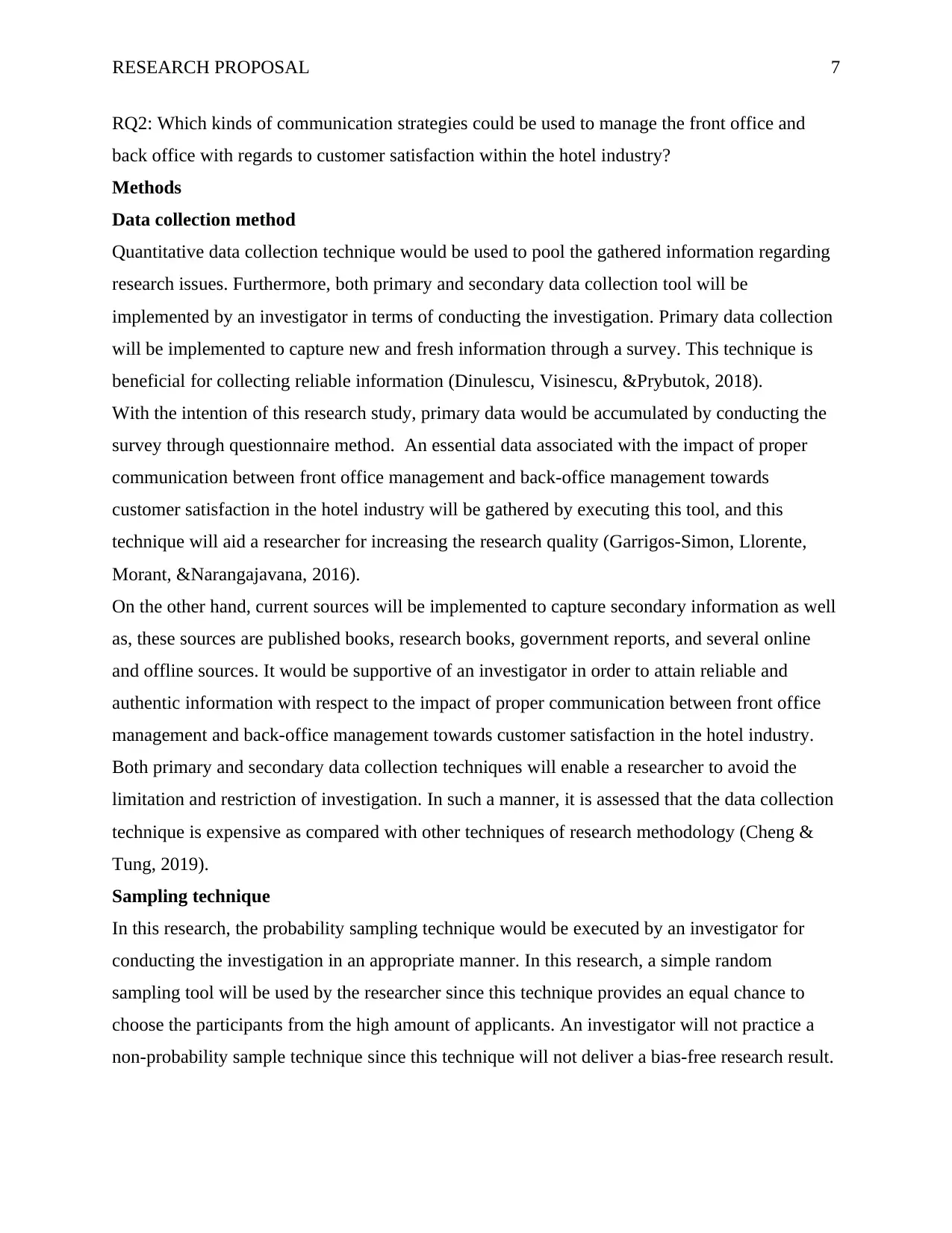
RESEARCH PROPOSAL 7
RQ2: Which kinds of communication strategies could be used to manage the front office and
back office with regards to customer satisfaction within the hotel industry?
Methods
Data collection method
Quantitative data collection technique would be used to pool the gathered information regarding
research issues. Furthermore, both primary and secondary data collection tool will be
implemented by an investigator in terms of conducting the investigation. Primary data collection
will be implemented to capture new and fresh information through a survey. This technique is
beneficial for collecting reliable information (Dinulescu, Visinescu, &Prybutok, 2018).
With the intention of this research study, primary data would be accumulated by conducting the
survey through questionnaire method. An essential data associated with the impact of proper
communication between front office management and back-office management towards
customer satisfaction in the hotel industry will be gathered by executing this tool, and this
technique will aid a researcher for increasing the research quality (Garrigos-Simon, Llorente,
Morant, &Narangajavana, 2016).
On the other hand, current sources will be implemented to capture secondary information as well
as, these sources are published books, research books, government reports, and several online
and offline sources. It would be supportive of an investigator in order to attain reliable and
authentic information with respect to the impact of proper communication between front office
management and back-office management towards customer satisfaction in the hotel industry.
Both primary and secondary data collection techniques will enable a researcher to avoid the
limitation and restriction of investigation. In such a manner, it is assessed that the data collection
technique is expensive as compared with other techniques of research methodology (Cheng &
Tung, 2019).
Sampling technique
In this research, the probability sampling technique would be executed by an investigator for
conducting the investigation in an appropriate manner. In this research, a simple random
sampling tool will be used by the researcher since this technique provides an equal chance to
choose the participants from the high amount of applicants. An investigator will not practice a
non-probability sample technique since this technique will not deliver a bias-free research result.
RQ2: Which kinds of communication strategies could be used to manage the front office and
back office with regards to customer satisfaction within the hotel industry?
Methods
Data collection method
Quantitative data collection technique would be used to pool the gathered information regarding
research issues. Furthermore, both primary and secondary data collection tool will be
implemented by an investigator in terms of conducting the investigation. Primary data collection
will be implemented to capture new and fresh information through a survey. This technique is
beneficial for collecting reliable information (Dinulescu, Visinescu, &Prybutok, 2018).
With the intention of this research study, primary data would be accumulated by conducting the
survey through questionnaire method. An essential data associated with the impact of proper
communication between front office management and back-office management towards
customer satisfaction in the hotel industry will be gathered by executing this tool, and this
technique will aid a researcher for increasing the research quality (Garrigos-Simon, Llorente,
Morant, &Narangajavana, 2016).
On the other hand, current sources will be implemented to capture secondary information as well
as, these sources are published books, research books, government reports, and several online
and offline sources. It would be supportive of an investigator in order to attain reliable and
authentic information with respect to the impact of proper communication between front office
management and back-office management towards customer satisfaction in the hotel industry.
Both primary and secondary data collection techniques will enable a researcher to avoid the
limitation and restriction of investigation. In such a manner, it is assessed that the data collection
technique is expensive as compared with other techniques of research methodology (Cheng &
Tung, 2019).
Sampling technique
In this research, the probability sampling technique would be executed by an investigator for
conducting the investigation in an appropriate manner. In this research, a simple random
sampling tool will be used by the researcher since this technique provides an equal chance to
choose the participants from the high amount of applicants. An investigator will not practice a
non-probability sample technique since this technique will not deliver a bias-free research result.
Paraphrase This Document
Need a fresh take? Get an instant paraphrase of this document with our AI Paraphraser
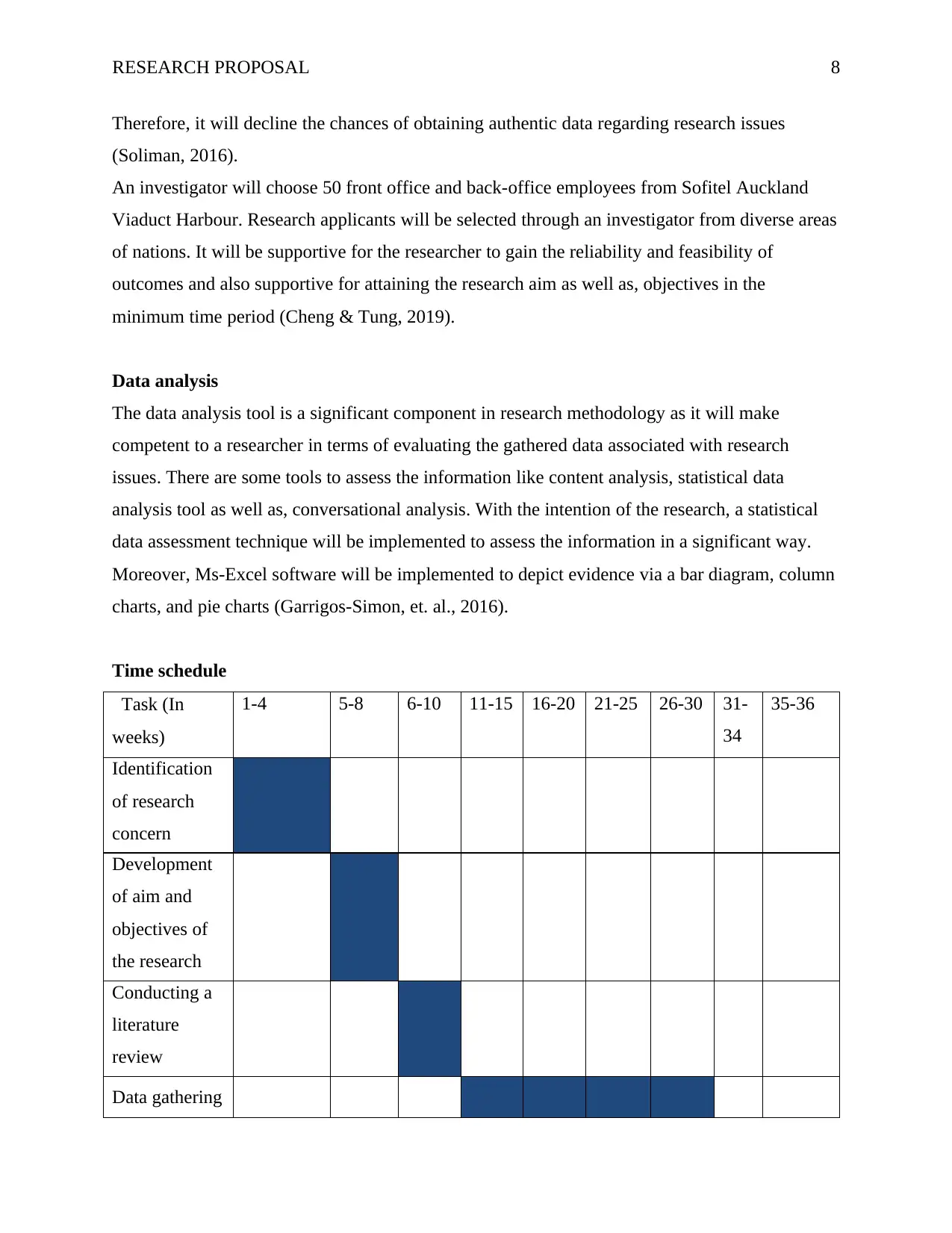
RESEARCH PROPOSAL 8
Therefore, it will decline the chances of obtaining authentic data regarding research issues
(Soliman, 2016).
An investigator will choose 50 front office and back-office employees from Sofitel Auckland
Viaduct Harbour. Research applicants will be selected through an investigator from diverse areas
of nations. It will be supportive for the researcher to gain the reliability and feasibility of
outcomes and also supportive for attaining the research aim as well as, objectives in the
minimum time period (Cheng & Tung, 2019).
Data analysis
The data analysis tool is a significant component in research methodology as it will make
competent to a researcher in terms of evaluating the gathered data associated with research
issues. There are some tools to assess the information like content analysis, statistical data
analysis tool as well as, conversational analysis. With the intention of the research, a statistical
data assessment technique will be implemented to assess the information in a significant way.
Moreover, Ms-Excel software will be implemented to depict evidence via a bar diagram, column
charts, and pie charts (Garrigos-Simon, et. al., 2016).
Time schedule
Task (In
weeks)
1-4 5-8 6-10 11-15 16-20 21-25 26-30 31-
34
35-36
Identification
of research
concern
Development
of aim and
objectives of
the research
Conducting a
literature
review
Data gathering
Therefore, it will decline the chances of obtaining authentic data regarding research issues
(Soliman, 2016).
An investigator will choose 50 front office and back-office employees from Sofitel Auckland
Viaduct Harbour. Research applicants will be selected through an investigator from diverse areas
of nations. It will be supportive for the researcher to gain the reliability and feasibility of
outcomes and also supportive for attaining the research aim as well as, objectives in the
minimum time period (Cheng & Tung, 2019).
Data analysis
The data analysis tool is a significant component in research methodology as it will make
competent to a researcher in terms of evaluating the gathered data associated with research
issues. There are some tools to assess the information like content analysis, statistical data
analysis tool as well as, conversational analysis. With the intention of the research, a statistical
data assessment technique will be implemented to assess the information in a significant way.
Moreover, Ms-Excel software will be implemented to depict evidence via a bar diagram, column
charts, and pie charts (Garrigos-Simon, et. al., 2016).
Time schedule
Task (In
weeks)
1-4 5-8 6-10 11-15 16-20 21-25 26-30 31-
34
35-36
Identification
of research
concern
Development
of aim and
objectives of
the research
Conducting a
literature
review
Data gathering
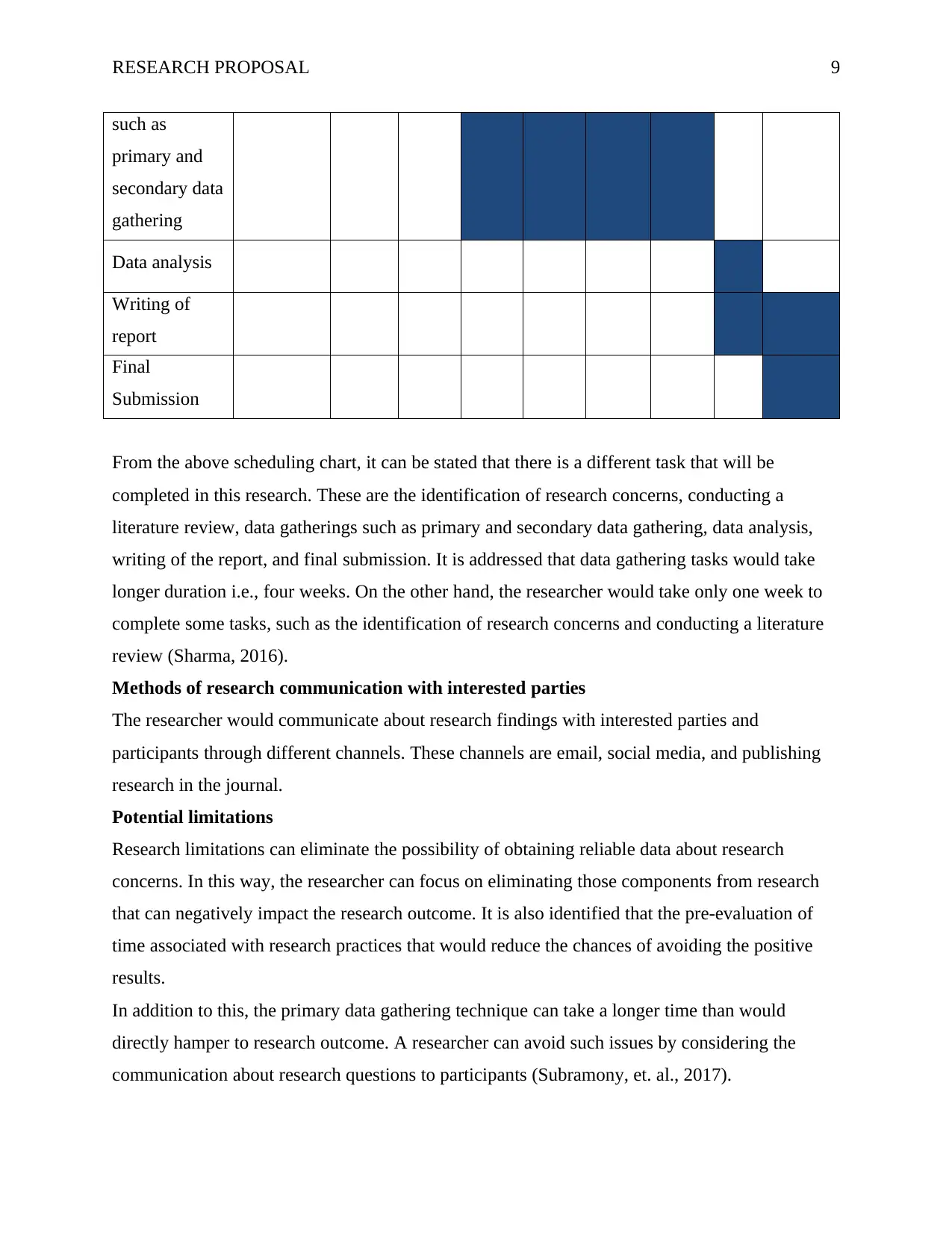
RESEARCH PROPOSAL 9
such as
primary and
secondary data
gathering
Data analysis
Writing of
report
Final
Submission
From the above scheduling chart, it can be stated that there is a different task that will be
completed in this research. These are the identification of research concerns, conducting a
literature review, data gatherings such as primary and secondary data gathering, data analysis,
writing of the report, and final submission. It is addressed that data gathering tasks would take
longer duration i.e., four weeks. On the other hand, the researcher would take only one week to
complete some tasks, such as the identification of research concerns and conducting a literature
review (Sharma, 2016).
Methods of research communication with interested parties
The researcher would communicate about research findings with interested parties and
participants through different channels. These channels are email, social media, and publishing
research in the journal.
Potential limitations
Research limitations can eliminate the possibility of obtaining reliable data about research
concerns. In this way, the researcher can focus on eliminating those components from research
that can negatively impact the research outcome. It is also identified that the pre-evaluation of
time associated with research practices that would reduce the chances of avoiding the positive
results.
In addition to this, the primary data gathering technique can take a longer time than would
directly hamper to research outcome. A researcher can avoid such issues by considering the
communication about research questions to participants (Subramony, et. al., 2017).
such as
primary and
secondary data
gathering
Data analysis
Writing of
report
Final
Submission
From the above scheduling chart, it can be stated that there is a different task that will be
completed in this research. These are the identification of research concerns, conducting a
literature review, data gatherings such as primary and secondary data gathering, data analysis,
writing of the report, and final submission. It is addressed that data gathering tasks would take
longer duration i.e., four weeks. On the other hand, the researcher would take only one week to
complete some tasks, such as the identification of research concerns and conducting a literature
review (Sharma, 2016).
Methods of research communication with interested parties
The researcher would communicate about research findings with interested parties and
participants through different channels. These channels are email, social media, and publishing
research in the journal.
Potential limitations
Research limitations can eliminate the possibility of obtaining reliable data about research
concerns. In this way, the researcher can focus on eliminating those components from research
that can negatively impact the research outcome. It is also identified that the pre-evaluation of
time associated with research practices that would reduce the chances of avoiding the positive
results.
In addition to this, the primary data gathering technique can take a longer time than would
directly hamper to research outcome. A researcher can avoid such issues by considering the
communication about research questions to participants (Subramony, et. al., 2017).
⊘ This is a preview!⊘
Do you want full access?
Subscribe today to unlock all pages.

Trusted by 1+ million students worldwide
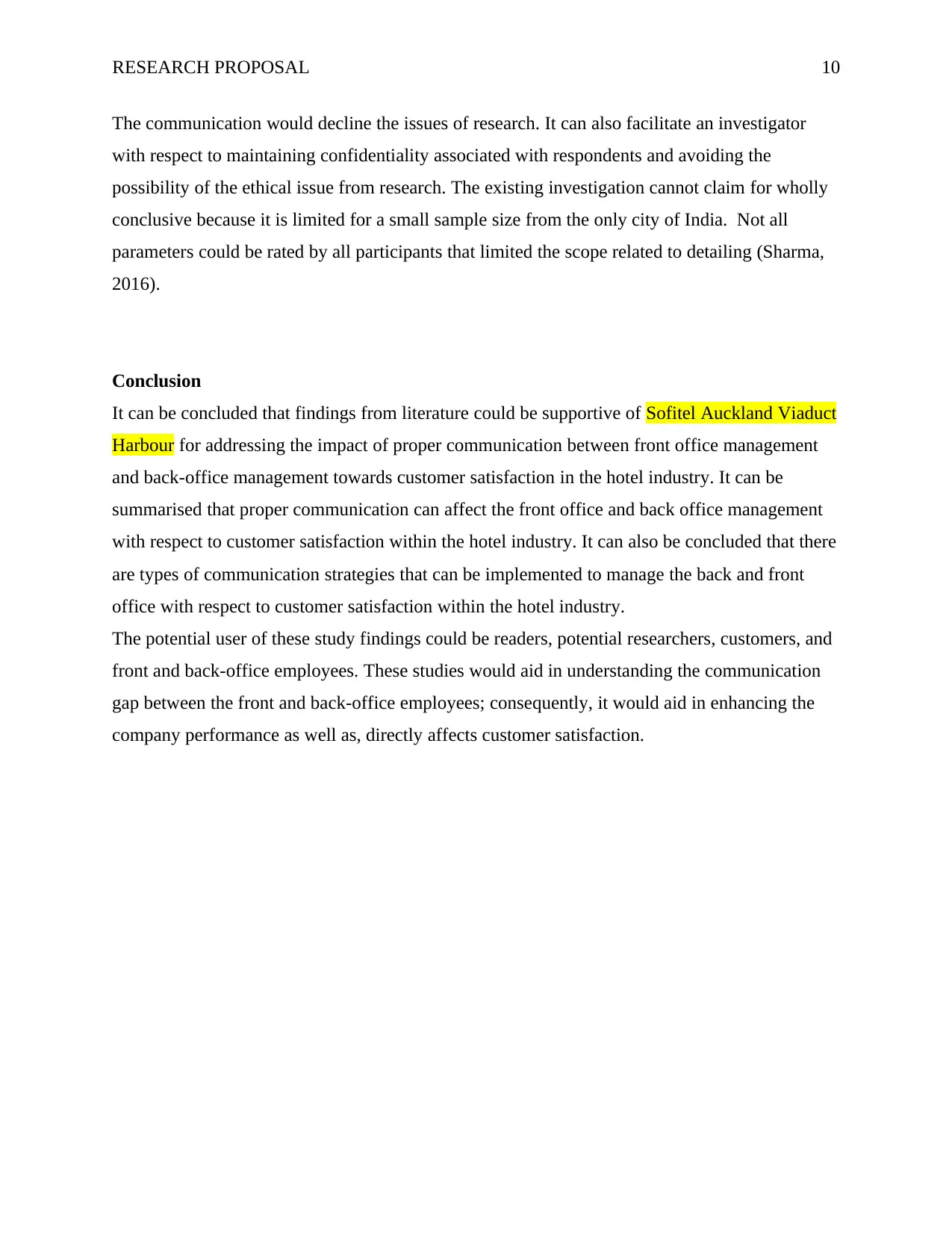
RESEARCH PROPOSAL 10
The communication would decline the issues of research. It can also facilitate an investigator
with respect to maintaining confidentiality associated with respondents and avoiding the
possibility of the ethical issue from research. The existing investigation cannot claim for wholly
conclusive because it is limited for a small sample size from the only city of India. Not all
parameters could be rated by all participants that limited the scope related to detailing (Sharma,
2016).
Conclusion
It can be concluded that findings from literature could be supportive of Sofitel Auckland Viaduct
Harbour for addressing the impact of proper communication between front office management
and back-office management towards customer satisfaction in the hotel industry. It can be
summarised that proper communication can affect the front office and back office management
with respect to customer satisfaction within the hotel industry. It can also be concluded that there
are types of communication strategies that can be implemented to manage the back and front
office with respect to customer satisfaction within the hotel industry.
The potential user of these study findings could be readers, potential researchers, customers, and
front and back-office employees. These studies would aid in understanding the communication
gap between the front and back-office employees; consequently, it would aid in enhancing the
company performance as well as, directly affects customer satisfaction.
The communication would decline the issues of research. It can also facilitate an investigator
with respect to maintaining confidentiality associated with respondents and avoiding the
possibility of the ethical issue from research. The existing investigation cannot claim for wholly
conclusive because it is limited for a small sample size from the only city of India. Not all
parameters could be rated by all participants that limited the scope related to detailing (Sharma,
2016).
Conclusion
It can be concluded that findings from literature could be supportive of Sofitel Auckland Viaduct
Harbour for addressing the impact of proper communication between front office management
and back-office management towards customer satisfaction in the hotel industry. It can be
summarised that proper communication can affect the front office and back office management
with respect to customer satisfaction within the hotel industry. It can also be concluded that there
are types of communication strategies that can be implemented to manage the back and front
office with respect to customer satisfaction within the hotel industry.
The potential user of these study findings could be readers, potential researchers, customers, and
front and back-office employees. These studies would aid in understanding the communication
gap between the front and back-office employees; consequently, it would aid in enhancing the
company performance as well as, directly affects customer satisfaction.
Paraphrase This Document
Need a fresh take? Get an instant paraphrase of this document with our AI Paraphraser
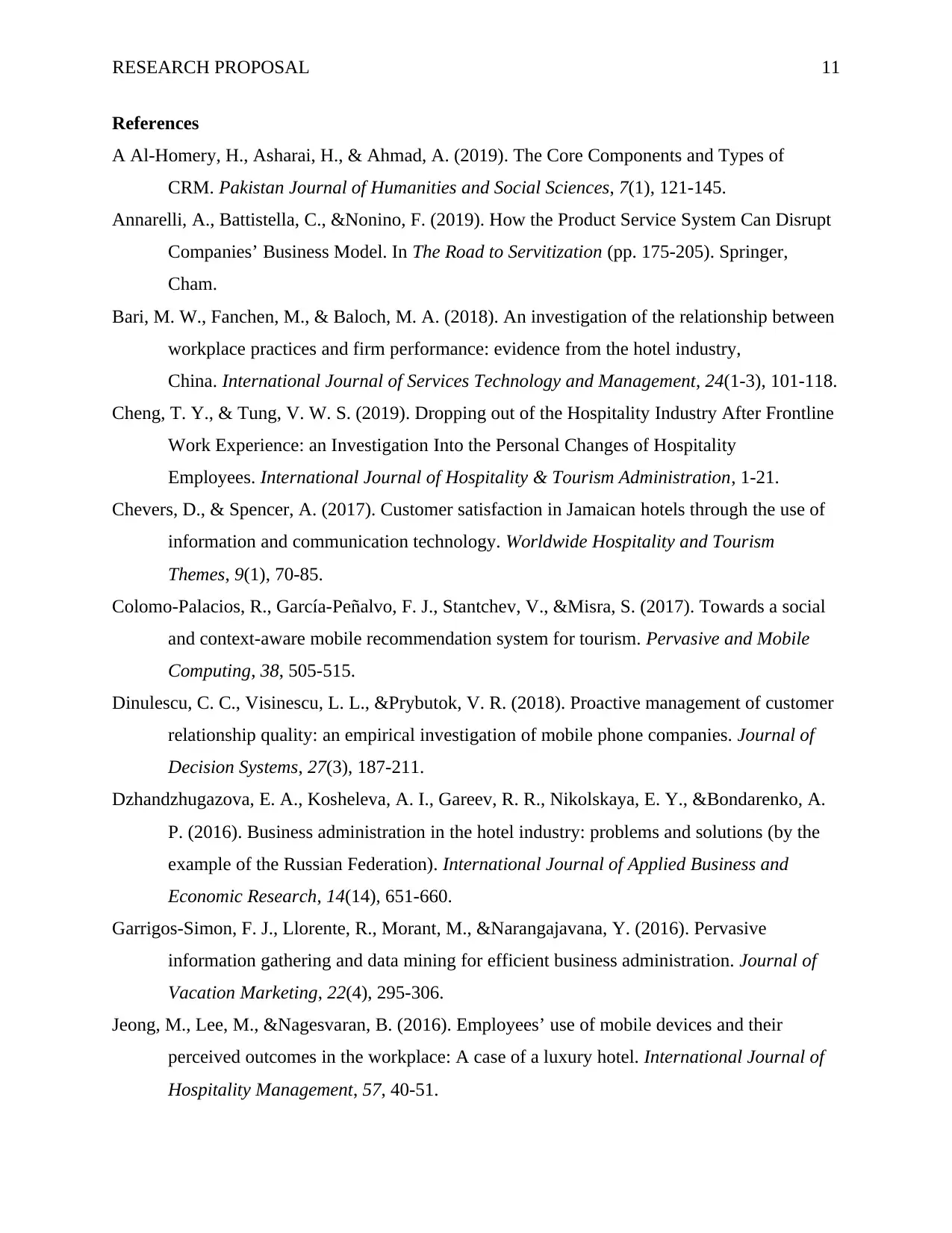
RESEARCH PROPOSAL 11
References
A Al-Homery, H., Asharai, H., & Ahmad, A. (2019). The Core Components and Types of
CRM. Pakistan Journal of Humanities and Social Sciences, 7(1), 121-145.
Annarelli, A., Battistella, C., &Nonino, F. (2019). How the Product Service System Can Disrupt
Companies’ Business Model. In The Road to Servitization (pp. 175-205). Springer,
Cham.
Bari, M. W., Fanchen, M., & Baloch, M. A. (2018). An investigation of the relationship between
workplace practices and firm performance: evidence from the hotel industry,
China. International Journal of Services Technology and Management, 24(1-3), 101-118.
Cheng, T. Y., & Tung, V. W. S. (2019). Dropping out of the Hospitality Industry After Frontline
Work Experience: an Investigation Into the Personal Changes of Hospitality
Employees. International Journal of Hospitality & Tourism Administration, 1-21.
Chevers, D., & Spencer, A. (2017). Customer satisfaction in Jamaican hotels through the use of
information and communication technology. Worldwide Hospitality and Tourism
Themes, 9(1), 70-85.
Colomo-Palacios, R., García-Peñalvo, F. J., Stantchev, V., &Misra, S. (2017). Towards a social
and context-aware mobile recommendation system for tourism. Pervasive and Mobile
Computing, 38, 505-515.
Dinulescu, C. C., Visinescu, L. L., &Prybutok, V. R. (2018). Proactive management of customer
relationship quality: an empirical investigation of mobile phone companies. Journal of
Decision Systems, 27(3), 187-211.
Dzhandzhugazova, E. A., Kosheleva, A. I., Gareev, R. R., Nikolskaya, E. Y., &Bondarenko, A.
P. (2016). Business administration in the hotel industry: problems and solutions (by the
example of the Russian Federation). International Journal of Applied Business and
Economic Research, 14(14), 651-660.
Garrigos-Simon, F. J., Llorente, R., Morant, M., &Narangajavana, Y. (2016). Pervasive
information gathering and data mining for efficient business administration. Journal of
Vacation Marketing, 22(4), 295-306.
Jeong, M., Lee, M., &Nagesvaran, B. (2016). Employees’ use of mobile devices and their
perceived outcomes in the workplace: A case of a luxury hotel. International Journal of
Hospitality Management, 57, 40-51.
References
A Al-Homery, H., Asharai, H., & Ahmad, A. (2019). The Core Components and Types of
CRM. Pakistan Journal of Humanities and Social Sciences, 7(1), 121-145.
Annarelli, A., Battistella, C., &Nonino, F. (2019). How the Product Service System Can Disrupt
Companies’ Business Model. In The Road to Servitization (pp. 175-205). Springer,
Cham.
Bari, M. W., Fanchen, M., & Baloch, M. A. (2018). An investigation of the relationship between
workplace practices and firm performance: evidence from the hotel industry,
China. International Journal of Services Technology and Management, 24(1-3), 101-118.
Cheng, T. Y., & Tung, V. W. S. (2019). Dropping out of the Hospitality Industry After Frontline
Work Experience: an Investigation Into the Personal Changes of Hospitality
Employees. International Journal of Hospitality & Tourism Administration, 1-21.
Chevers, D., & Spencer, A. (2017). Customer satisfaction in Jamaican hotels through the use of
information and communication technology. Worldwide Hospitality and Tourism
Themes, 9(1), 70-85.
Colomo-Palacios, R., García-Peñalvo, F. J., Stantchev, V., &Misra, S. (2017). Towards a social
and context-aware mobile recommendation system for tourism. Pervasive and Mobile
Computing, 38, 505-515.
Dinulescu, C. C., Visinescu, L. L., &Prybutok, V. R. (2018). Proactive management of customer
relationship quality: an empirical investigation of mobile phone companies. Journal of
Decision Systems, 27(3), 187-211.
Dzhandzhugazova, E. A., Kosheleva, A. I., Gareev, R. R., Nikolskaya, E. Y., &Bondarenko, A.
P. (2016). Business administration in the hotel industry: problems and solutions (by the
example of the Russian Federation). International Journal of Applied Business and
Economic Research, 14(14), 651-660.
Garrigos-Simon, F. J., Llorente, R., Morant, M., &Narangajavana, Y. (2016). Pervasive
information gathering and data mining for efficient business administration. Journal of
Vacation Marketing, 22(4), 295-306.
Jeong, M., Lee, M., &Nagesvaran, B. (2016). Employees’ use of mobile devices and their
perceived outcomes in the workplace: A case of a luxury hotel. International Journal of
Hospitality Management, 57, 40-51.
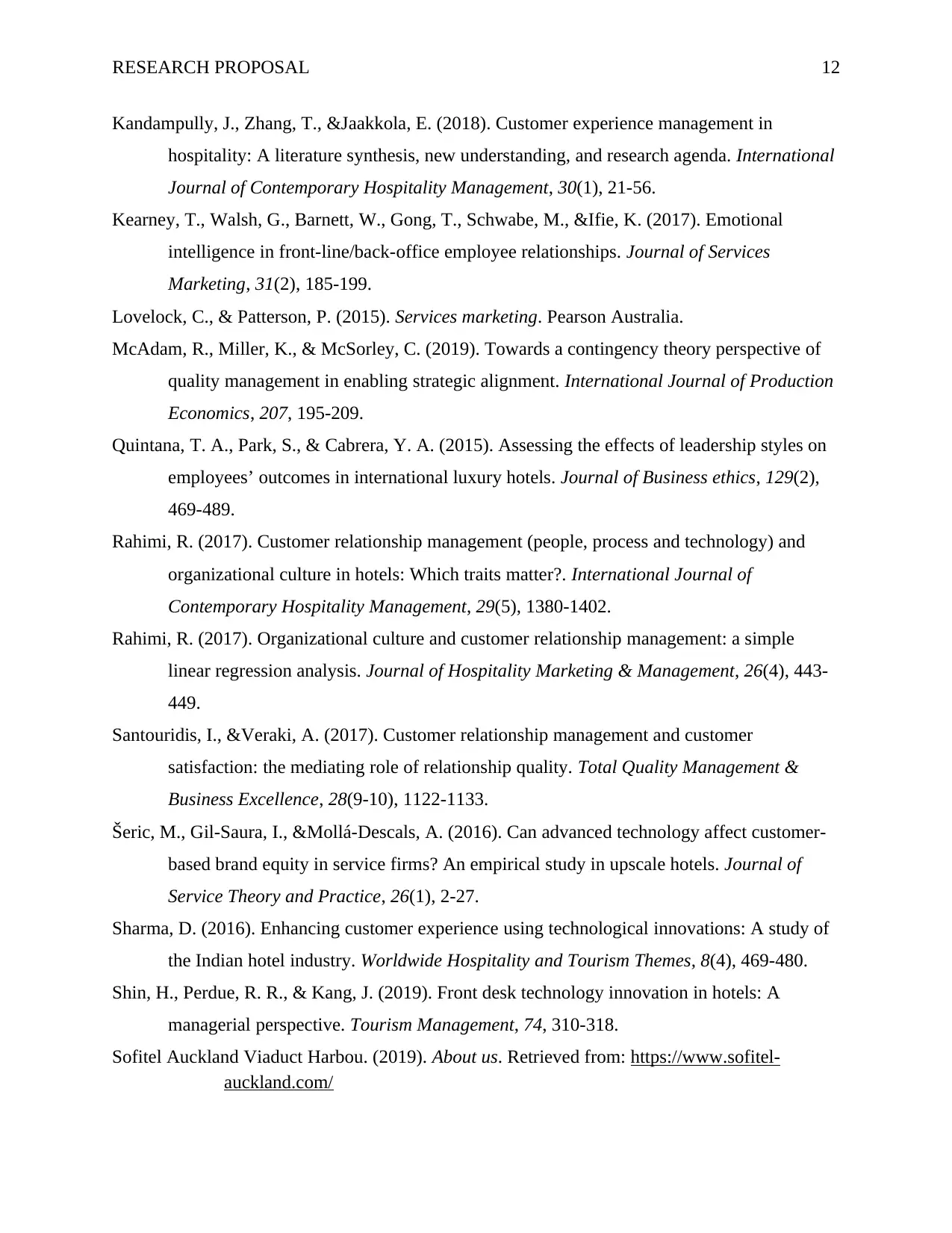
RESEARCH PROPOSAL 12
Kandampully, J., Zhang, T., &Jaakkola, E. (2018). Customer experience management in
hospitality: A literature synthesis, new understanding, and research agenda. International
Journal of Contemporary Hospitality Management, 30(1), 21-56.
Kearney, T., Walsh, G., Barnett, W., Gong, T., Schwabe, M., &Ifie, K. (2017). Emotional
intelligence in front-line/back-office employee relationships. Journal of Services
Marketing, 31(2), 185-199.
Lovelock, C., & Patterson, P. (2015). Services marketing. Pearson Australia.
McAdam, R., Miller, K., & McSorley, C. (2019). Towards a contingency theory perspective of
quality management in enabling strategic alignment. International Journal of Production
Economics, 207, 195-209.
Quintana, T. A., Park, S., & Cabrera, Y. A. (2015). Assessing the effects of leadership styles on
employees’ outcomes in international luxury hotels. Journal of Business ethics, 129(2),
469-489.
Rahimi, R. (2017). Customer relationship management (people, process and technology) and
organizational culture in hotels: Which traits matter?. International Journal of
Contemporary Hospitality Management, 29(5), 1380-1402.
Rahimi, R. (2017). Organizational culture and customer relationship management: a simple
linear regression analysis. Journal of Hospitality Marketing & Management, 26(4), 443-
449.
Santouridis, I., &Veraki, A. (2017). Customer relationship management and customer
satisfaction: the mediating role of relationship quality. Total Quality Management &
Business Excellence, 28(9-10), 1122-1133.
Šeric, M., Gil-Saura, I., &Mollá-Descals, A. (2016). Can advanced technology affect customer-
based brand equity in service firms? An empirical study in upscale hotels. Journal of
Service Theory and Practice, 26(1), 2-27.
Sharma, D. (2016). Enhancing customer experience using technological innovations: A study of
the Indian hotel industry. Worldwide Hospitality and Tourism Themes, 8(4), 469-480.
Shin, H., Perdue, R. R., & Kang, J. (2019). Front desk technology innovation in hotels: A
managerial perspective. Tourism Management, 74, 310-318.
Sofitel Auckland Viaduct Harbou. (2019). About us. Retrieved from: https://www.sofitel-
auckland.com/
Kandampully, J., Zhang, T., &Jaakkola, E. (2018). Customer experience management in
hospitality: A literature synthesis, new understanding, and research agenda. International
Journal of Contemporary Hospitality Management, 30(1), 21-56.
Kearney, T., Walsh, G., Barnett, W., Gong, T., Schwabe, M., &Ifie, K. (2017). Emotional
intelligence in front-line/back-office employee relationships. Journal of Services
Marketing, 31(2), 185-199.
Lovelock, C., & Patterson, P. (2015). Services marketing. Pearson Australia.
McAdam, R., Miller, K., & McSorley, C. (2019). Towards a contingency theory perspective of
quality management in enabling strategic alignment. International Journal of Production
Economics, 207, 195-209.
Quintana, T. A., Park, S., & Cabrera, Y. A. (2015). Assessing the effects of leadership styles on
employees’ outcomes in international luxury hotels. Journal of Business ethics, 129(2),
469-489.
Rahimi, R. (2017). Customer relationship management (people, process and technology) and
organizational culture in hotels: Which traits matter?. International Journal of
Contemporary Hospitality Management, 29(5), 1380-1402.
Rahimi, R. (2017). Organizational culture and customer relationship management: a simple
linear regression analysis. Journal of Hospitality Marketing & Management, 26(4), 443-
449.
Santouridis, I., &Veraki, A. (2017). Customer relationship management and customer
satisfaction: the mediating role of relationship quality. Total Quality Management &
Business Excellence, 28(9-10), 1122-1133.
Šeric, M., Gil-Saura, I., &Mollá-Descals, A. (2016). Can advanced technology affect customer-
based brand equity in service firms? An empirical study in upscale hotels. Journal of
Service Theory and Practice, 26(1), 2-27.
Sharma, D. (2016). Enhancing customer experience using technological innovations: A study of
the Indian hotel industry. Worldwide Hospitality and Tourism Themes, 8(4), 469-480.
Shin, H., Perdue, R. R., & Kang, J. (2019). Front desk technology innovation in hotels: A
managerial perspective. Tourism Management, 74, 310-318.
Sofitel Auckland Viaduct Harbou. (2019). About us. Retrieved from: https://www.sofitel-
auckland.com/
⊘ This is a preview!⊘
Do you want full access?
Subscribe today to unlock all pages.

Trusted by 1+ million students worldwide
1 out of 13
Related Documents
Your All-in-One AI-Powered Toolkit for Academic Success.
+13062052269
info@desklib.com
Available 24*7 on WhatsApp / Email
![[object Object]](/_next/static/media/star-bottom.7253800d.svg)
Unlock your academic potential
Copyright © 2020–2025 A2Z Services. All Rights Reserved. Developed and managed by ZUCOL.




